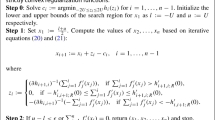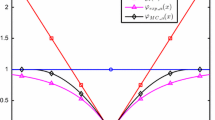Abstract
Total variation (TV) signal denoising is a popular nonlinear filtering method to estimate piecewise constant signals corrupted by additive white Gaussian noise. Following a ‘convex non-convex’ strategy, recent papers have introduced non-convex regularizers for signal denoising that preserve the convexity of the cost function to be minimized. In this paper, we propose a non-convex TV regularizer, defined using concepts from convex analysis, that unifies, generalizes, and improves upon these regularizers. In particular, we use the generalized Moreau envelope which, unlike the usual Moreau envelope, incorporates a matrix parameter. We describe a novel approach to set the matrix parameter which is essential for realizing the improvement we demonstrate. Additionally, we describe a new set of algorithms for non-convex TV denoising that elucidate the relationship among them and which build upon fast exact algorithms for classical TV denoising.











Similar content being viewed by others
References
Bauschke, H.H., Combettes, P.L.: Convex Analysis and Monotone Operator Theory in Hilbert Spaces. Springer, Berlin (2011)
Bayram, I.: Correction for On the convergence of the iterative shrinkage/thresholding algorithm with a weakly convex penalty. IEEE Trans. Signal Process. 64(14), 3822–3822 (2016)
Bayram, I.: On the convergence of the iterative shrinkage/thresholding algorithm with a weakly convex penalty. IEEE Trans. Signal Process. 64(6), 1597–1608 (2016)
Becker, S., Combettes, P.L.: An algorithm for splitting parallel sums of linearly composed monotone operators, with applications to signal recovery. J. Nonlinear Convex Anal. 15(1), 137–159 (2014)
Blake, A., Zisserman, A.: Visual Reconstruction. MIT Press, Cambridge (1987)
Burger, M., Papafitsoros, K., Papoutsellis, E., Schönlieb, C.-B.: Infimal convolution regularisation functionals of BV and Lp spaces. J. Math. Imaging Vis. 55(3), 343–369 (2016)
Cai, G., Selesnick, I.W., Wang, S., Dai, W., Zhu, Z.: Sparsity-enhanced signal decomposition via generalized minimax-concave penalty for gearbox fault diagnosis. J. Sound Vib. 432, 213–234 (2018)
Candès, E.J., Wakin, M.B., Boyd, S.: Enhancing sparsity by reweighted l1 minimization. J. Fourier Anal. Appl. 14(5), 877–905 (2008)
Carlsson, M.: On convexification/optimization of functionals including an l2-misfit term. arXiv preprint arXiv:1609.09378 (2016)
Castella, M., Pesquet, J.-C.: Optimization of a Geman-McClure like criterion for sparse signal deconvolution. In: IEEE International Workshop on Computational Advances Multi-Sensor Adaptive Processing, pp. 309–312 (2015)
Chambolle, A., Lions, P.-L.: Image recovery via total variation minimization and related problems. Numerische Mathematik 76, 167–188 (1997)
Chan, R., Lanza, A., Morigi, S., Sgallari, F.: Convex non-convex image segmentation. Numerische Mathematik 138(3), 635–680 (2017)
Chan, T.F., Osher, S., Shen, J.: The digital TV filter and nonlinear denoising. IEEE Trans. Image Process. 10(2), 231–241 (2001)
Chartrand, R.: Shrinkage mappings and their induced penalty functions, pp. 1026–1029. In: International Conference on Acoustics, Speech and Signal Processing (ICASSP) (2014)
Chouzenoux, E., Jezierska, A., Pesquet, J., Talbot, H.: A majorize-minimize subspace approach for \(\ell _2-\ell _0\) image regularization. SIAM J. Imag. Sci. 6(1), 563–591 (2013)
Combettes, P.L., Pesquet, J.-C.: Proximal splitting methods in signal processing. In: Bauschke, H.H., et al. (eds.) Fixed-Point Algorithms for Inverse Problems in Science and Engineering, pp. 185–212. Springer, Berlin (2011)
Condat, L.: A direct algorithm for 1-D total variation denoising. IEEE Signal Process. Lett. 20(11), 1054–1057 (2013)
Ding, Y., Selesnick, I.W.: Artifact-free wavelet denoising: non-convex sparse regularization, convex optimization. IEEE Signal Process. Lett. 22(9), 1364–1368 (2015)
Donoho, D., Maleki, A., Shahram, M.: Wavelab 850 (2005). http://www-stat.stanford.edu/%7Ewavelab/
Du, H., Liu, Y.: Minmax-concave total variation denoising. Signal Image Video Process. 12(6), 1027–1034 (2018)
Dümbgen, L., Kovac, A.: Extensions of smoothing via taut strings. Electron. J. Stat. 3, 41–75 (2009)
Frecon, J., Pustelnik, N., Dobigeon, N., Wendt, H., Abry, P.: Bayesian selection for the l2-Potts model regularization parameter: 1D piecewise constant signal denoising. IEEE Trans. Signal Process. 65(19), 5215–5224 (2017)
Friedrich, F., Kempe, A., Liebscher, V., Winkler, G.: Complexity penalized M-estimation: fast computation. J. Comput. Graph. Stat. 17(1), 201–224 (2008)
Huska, M., Lanza, A., Morigi, S., Sgallari, F.: Convex non-convex segmentation of scalar fields over arbitrary triangulated surfaces. J. Comput. Appl. Math. 349, 438–451 (2019)
Lanza, A., Morigi, S., Selesnick, I., Sgallari, F.: Nonconvex nonsmooth optimization via convex-nonconvex majorization-minimization. Numerische Mathematik 136(2), 343–381 (2017)
Lanza, A., Morigi, S., Selesnick, I., Sgallari, F.: Sparsity-inducing nonconvex nonseparable regularization for convex image processing. SIAM J. Imag. Sci. 12(2), 1099–1134 (2019)
Lanza, A., Morigi, S., Sgallari, F.: Constrained TVp-l2 model for image restoration. J. Sci. Comput. 68(1), 64–91 (2016)
Lanza, A., Morigi, S., Sgallari, F.: Convex image denoising via non-convex regularization with parameter selection. J. Math. Imaging Vis. 56(2), 195–220 (2016)
Little, M.A., Jones, N.S.: Generalized methods and solvers for noise removal from piecewise constant signals: part I - background theory. Proc. R. Soc. A 467, 3088–3114 (2011)
Malek-Mohammadi, M., Rojas, C.R., Wahlberg, B.: A class of nonconvex penalties preserving overall convexity in optimization-based mean filtering. IEEE Trans. Signal Process. 64(24), 6650–6664 (2016)
Möllenhoff, T., Strekalovskiy, E., Moeller, M., Cremers, D.: The primal-dual hybrid gradient method for semiconvex splittings. SIAM J. Imag. Sci. 8(2), 827–857 (2015)
Nikolova, M.: Estimation of binary images by minimizing convex criteria. In: Proceedings of IEEE International Conference on Image Processing (ICIP), vol. 2, pp. 108–112 (1998)
Nikolova, M.: Energy minimization methods. In: Scherzer, O. (ed.) Handbook of Mathematical Methods in Imaging, Chapter 5, pp. 138–186. Springer, Berlin (2011)
Nikolova, M., Ng, M., Zhang, S., Ching, W.: Efficient reconstruction of piecewise constant images using nonsmooth nonconvex minimization. SIAM J. Imag. Sci. 1(1), 2–25 (2008)
Nikolova, M., Ng, M.K., Tam, C.-P.: Fast nonconvex nonsmooth minimization methods for image restoration and reconstruction. IEEE Trans. Image Process. 19(12), 3073–3088 (2010)
Parekh, A., Selesnick, I.W.: Convex denoising using non-convex tight frame regularization. IEEE Signal Process. Lett. 22(10), 1786–1790 (2015)
Parekh, A., Selesnick, I.W.: Enhanced low-rank matrix approximation. IEEE Signal Process. Lett. 23(4), 493–497 (2016)
Parks, T.W., Burrus, C.S.: Digital Filter Design. Wiley, Hoboken (1987)
Portilla, J., Mancera, L.: L0-based sparse approximation: two alternative methods and some applications. In: Proceedings of SPIE, vol. 6701 (Wavelets XII), San Diego, CA, USA, (2007)
Rudin, L., Osher, S., Fatemi, E.: Nonlinear total variation based noise removal algorithms. Phys. D 60, 259–268 (1992)
Selesnick, I.: Sparse regularization via convex analysis. IEEE Trans. Signal Process. 65(17), 4481–4494 (2017)
Selesnick, I.: Total variation denoising via the Moreau envelope. IEEE Signal Process. Lett. 24(2), 216–220 (2017)
Selesnick, I.W., Bayram, I.: Sparse signal estimation by maximally sparse convex optimization. IEEE Trans. Signal Process. 62(5), 1078–1092 (2014)
Selesnick, I.W., Parekh, A., Bayram, I.: Convex 1-D total variation denoising with non-convex regularization. IEEE Signal Process. Lett. 22(2), 141–144 (2015)
Setzer, S., Steidl, G., Teuber, T.: Infimal convolution regularizations with discrete l1-type functionals. Commun. Math. Sci. 9(3), 797–827 (2011)
Shen, L., Suter, B.W., Tripp, E.E.: Structured sparsity promoting functions. J. Optim. Theory Appl. 183(2), 386–421 (2019)
Shen, L., Xu, Y., Zeng, X.: Wavelet inpainting with the l0 sparse regularization. J. Appl. Comp. Harm. Anal. 41(1), 26–53 (2016)
Sidky, E.Y., Chartrand, R., Boone, J.M., Xiaochuan, P.: Constrained TpV minimization for enhanced exploitation of gradient sparsity: application to CT image reconstruction. IEEE J. Transl. Eng. Health Med. 2, 1–18 (2014)
Soubies, E., Blanc-Féraud, L., Aubert, G.: A continuous exact \( \ell _0 \) penalty (CEL0) for least squares regularized problem. SIAM J. Imag. Sci. 8(3), 1607–1639 (2015)
Storath, M., Weinmann, A., Demaret, L.: Jump-sparse and sparse recovery using Potts functionals. IEEE Trans. Signal Process. 62(14), 3654–3666 (2014)
Strang, G.: The discrete cosine transform. SIAM Rev. 41(1), 135–147 (1999)
Wang, S., Selesnick, I.W., Cai, G., Ding, B., Chen, X.: Synthesis versus analysis priors via generalized minimax-concave penalty for sparsity-assisted machinery fault diagnosis. Mech. Syst. Signal Process. 127, 202–233 (2019)
Zhang, C.-H.: Nearly unbiased variable selection under minimax concave penalty. Ann. Stat. 38(2), 894–942 (2010)
Zou, J., Shen, M., Zhang, Y., Li, H., Liu, G., Ding, S.: Total variation denoising with non-convex regularizers. IEEE Access 7, 4422–4431 (2019)
Funding
This study was funded by the National Science Foundation (Grant No. CCF-1525398) and University of Bologna (Grant No. ex 60%) and by the National Group for Scientific Computation (GNCS-INDAM), research projects 2018–19.
Author information
Authors and Affiliations
Corresponding author
Additional information
Publisher's Note
Springer Nature remains neutral with regard to jurisdictional claims in published maps and institutional affiliations.
Appendix
Appendix
In this Appendix, we present technical results and their proofs, which are needed for the main results of the paper.
Lemma 2
Let \( y \in \mathbb {R}^N \) and \( {\lambda } > 0 \). Let \( f \in \Gamma _0(\mathbb {R}^N) \) and \( B \in \mathbb {R}^{M \times N} \). Define \( g :\mathbb {R}^N \rightarrow \mathbb {R}\) as
where \( f^{\mathsf {M}}_B \) is the generalized Moreau envelope of f. If \( B^{\mathsf {T}}\! B \preccurlyeq (1 / {\lambda } ) I \), then g is convex. If \( B^{\mathsf {T}}\! B \prec (1 / {\lambda } ) I \), then g is strongly convex.
Proof
We write
The function in the curly braces is affine in x (hence convex in x). Since the supremum of a family of convex functions (here indexed by v) is itself convex, the final term of (83) is convex in x. Hence, g is convex if \( I - {\lambda } B^{\mathsf {T}}\! B \) is positive semidefinite; and g is strongly convex if \( I - {\lambda } B^{\mathsf {T}}\! B \) is positive definite. \(\square \)
Lemma 3
In the context of Lemma 2, let \(e_{\max }\) denote the maximum eigenvalue of \( B^{\mathsf {T}}\! B \). If \( B^{\mathsf {T}}\! B \prec (1 / {\lambda } ) I \) (that is, \( e_{\max } < 1/{\lambda } \)), then g in (81) is \( \delta \)-strongly convex with (positive) modulus of strong convexity (at least) equal to
Proof
It follows from Definition 3 that the function g in (81) is \( \delta \)-strongly convex if and only if the function \( {\widetilde{g}} \), defined by
is convex. Hence, \( {\widetilde{g}} \) in (86) is convex if \( (1- \delta )I - {\lambda } B^{\mathsf {T}}\! B\) is positive semidefinite. Let \( e_i \) be the real nonnegative eigenvalues of \( B^{\mathsf {T}}B\). We have
which completes the proof. \(\square \)
In this paper, we use the forward-backward splitting (FBS) algorithm which entails a constant of Lipschitz continuity. The following two lemmas regard Lipschitz continuity. Lemma 4 is a part [equivalence (i) \( \Leftrightarrow \) (vi)] of Theorem 18.15 of Ref. [1]. Our use of this result follows the reasoning of Ref. [2].
Lemma 4
Let \( f :\mathbb {R}^N \rightarrow \mathbb {R}\) be convex and differentiable. Then the gradient \( \nabla f \) is \( \rho \)-Lipschitz continuous if and only if \( (\rho /2) \Vert {\,\cdot \,} \Vert _2^2 - f \) is convex.
Lemma 5
Let \( y \in \mathbb {R}^N \) and \( {\lambda } > 0 \). Let \( B = C D \in \mathbb {R}^{M \times N} \) with \( B^{\mathsf {T}}\! B \preccurlyeq (1 / {\lambda } ) I \). Define \( f :\mathbb {R}^N \rightarrow \mathbb {R}\) as
where \( S_C \) is the generalized Huber function (34). Then the gradient \( \nabla f \) is Lipschitz continuous with a Lipschitz constant of 1.
Proof
The proof uses Lemma 4. Since both terms in (87) are differentiable, f is differentiable. Next, we show f is convex. Using (35), we write f as
The first term is convex because \( B^{\mathsf {T}}\! B \preccurlyeq (1 / {\lambda } ) I \). The term inside the curly braces is affine in x (hence convex in x). Since the minimum of a set of convex functions (here indexed by v) is convex, f is convex. By Lemma 4, it remains to show \( (1/2) \Vert {\,\cdot \,} \Vert _2^2 - f \) is convex. We have
By Proposition 3, the generalized Huber function is convex. Hence, the right-hand side is convex in x which completes the proof. \(\square \)
Rights and permissions
About this article
Cite this article
Selesnick, I., Lanza, A., Morigi, S. et al. Non-convex Total Variation Regularization for Convex Denoising of Signals. J Math Imaging Vis 62, 825–841 (2020). https://doi.org/10.1007/s10851-019-00937-5
Received:
Accepted:
Published:
Issue Date:
DOI: https://doi.org/10.1007/s10851-019-00937-5




